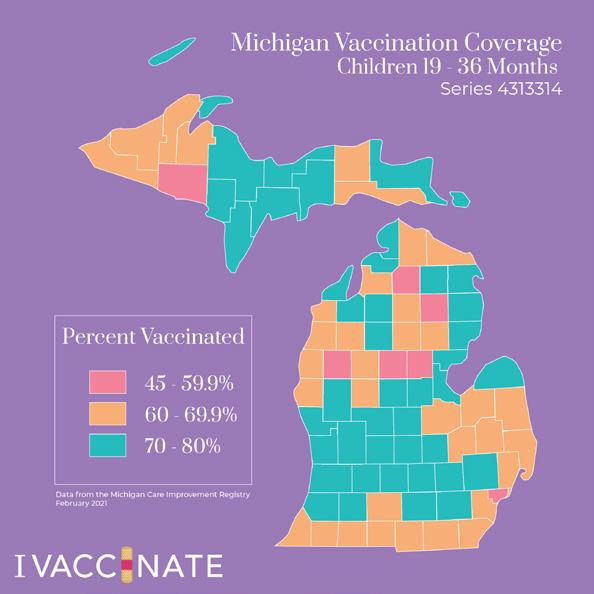
6 minute read
MSMS Update
By: Daniel M. Ryan, MD, MSMS Region 2 Director
SAFEHAVEN™ NOW OFFERING MICHIGAN PHYSICIANS & HEALTH CARE PROVIDERS RESOURCES TO MANAGE STRESS AND BURNOUT
Advertisement
New program offers physicians and health care providers with the resources they need to meet the demands of their personal and professional lives. In an effort to better serve and support clinicians struggling with stress, burnout and the effects of COVID-19, the Michigan State Medical Society (MSMS) has launched SafeHaven™, a comprehensive and confidential physician and health care provider well-being program offering clinicians with the resources and support they need to address career fatigue and behavioral health concerns.
“Physician burnout has been a growing problem for years now and that’s only been exasperated by the COVID-19 pandemic,” said Kevin McFatridge, chief operating officer of MSMS. “The fact is, we need to do a better job of caring for our physicians, nurses, physician assistants and all health care providers so that they in turn can continue to provide excellent quality care for Michigan’s patients—that’s what SafeHaven™ is all about. Our hope is this new resource will go a long way towards relieving our overly burdened provider community and ultimately help them rediscover the meaning, joy and purpose in practicing medicine.” SafeHaven™, which is implemented in partnership with VITAL WorkLife, provides a host of discreet and confidential set of tools and resources they can access to stay well, avoid burnout, and connect to their purpose without the fear of undue repercussions to their medical license.
“Most who work in health care do not see themselves as heroes and don’t do well seeking help for themselves, instead focusing on the needs of others in their care,” said Terri Babineau, MD, CMO of SafeHaven™. “Being only human, health care workers need the opportunity to seek help for mental health reasons without fear of harm to their career. The SafeHaven™ Program offers necessary mental health resources that are truly confidential and actually support health care workers.” SafeHaven™ resources are available to providers and their families and include the following: • In-the-moment telephonic support, available 24/7. • Counseling sessions. • Peer coaching. • Legal and financial consultations and resources, available 24/7. • WorkLife Concierge—a virtual assistant to help with tasks, available 24/7. • VITAL WorkLife App providing mobile access to SafeHaven™ resources.
For more information about SafeHaven™, please visit www.MSMS.org/SafeHaven.
TELEHEALTH FROM THE FIELD: CASE STUDY INVOLVING REMOTE MONITORING PROBLEMS
Even before the COVID-19 pandemic, the use of remote patient monitoring was expanding. The technologies offer many benefits, but they may also create potential malpractice risks. Consider the following case example and strategies that can help mitigate risks.
Case Example
During an annual physical, the physician recommended ambulatory electrocardiography for a patient with a history of prior cardiac arrhythmia. The physician told the patient he would receive the ambulatory monitor by mail and that the package would contain everything he needed. About a week later, the monitoring package arrived. He opened it, read the instructions, and applied the device. After a few hours, the device fell off. He reapplied it multiple times, but the device continued to fall off. After several calls with the device manufacturer, the patient gave up, tucked the device in the box, and mailed it back to the manufacturer.
A week later, the patient received a letter from the physician, stating that his monitoring results were normal. The patient—who was surprised to receive these results—followed up. During the discussion, the physician told him that the device manufacturer downloaded and evaluated the results and provided a report that the physician then shared with the patient. The physician was surprised to learn that the patient had not completed the monitoring period and the device had not performed as expected, but the results were still reported as normal. The patient lost confidence in both the physician and remote monitoring technology and did not return to the practice.
Patient Safety Strategies
Whether you have already implemented remote patient monitoring or are thinking about it, consider the following strategies: Use a deliberate process to evaluate and select remote patient monitoring devices. • Determine how the data will be collected, transmitted, stored and reported. In the case example, the manufacturer reported the study as normal even though the full monitor ing period was not completed. • Ensure the patient is ready to participate. Advise patients to call the office about any device problems or concerns. In the case scenario, the device did not adhere properly to the patient’s skin.
Plan and Prepare
This case study highlights the importance of careful planning and preparation when incorporating remote technologies into the patient care services offered by a medical practice. Providers who recommend products and services to their patients have a responsibility to apply due diligence in confirming that the device manufacturer is reputable, the device is safe, and the information it produces is accurate and reliable. Once a decision is made to use remote technology, the next steps should be to develop appropriate use guidelines that include preparing patients, managing device concerns/troubleshooting, tracking results, and following up with patients.
NEW MSMS HEALTH LAW UPDATE ON INFORMATION BLOCKING RULE

MSMS Legal Counsel created a new resource to help physicians and their practices comply with the 21st Century Cures Act (the “Cures Act”) and related final rule on Interoperability, Information Blocking, and the ONC Health IT Certification Program (the “Final Rule”). The Cures Act and its administrative rules regulate health care providers (including physicians in private practice and their medical practices), HIT developers of certified health IT, health information exchanges, and health information networks. The new MSMS Health Law Update provides an overview of the Cures Act and Final Rules, as well as addresses several frequently asked questions related to care delivery and information sharing. View the full legal alert on MSMS website here. Join MSMS for our Grand Rounds live webinar series on May 12th from 12 pm-12:45 pm where we will focus on the CURES Act: What is Information Blocking and How Do I Comply?
DOCTORS, PUBLIC HEALTH LEADERS URGE MICHIGAN PARENTS TO ‘CATCH UP’ CHILDREN ON ROUTINE VACCINATIONS
In 42 Michigan Counties, Children’s Vaccination Rates Have Dropped Below 70%
Doctors, nurses, hospitals, and state and national public health leaders urge Michigan parents to get their children up to date on vaccinations to prevent serious communicable diseases such as measles, mumps, pertussis, chickenpox and more from spreading as the state reopens after the COVID-19 pandemic. In many states including Michigan, vaccination rates of younger children dropped during the pandemic as parents postponed well-child visits to protect their kids from COVID-19. As a result, vaccination rates for Michigan children ages 19 to 36 months have fallen below 70% in more than half of the state (42 of 83 Michigan counties), according to February data from the Michigan Care Improvement Registry (MCIR). In six Michigan counties and the City of Detroit, the rate has dropped below 60%. While community immunity is different for each disease and vaccine, doctors and public health experts generally agree that a 70% vaccination rate is the minimum protection level desired. “At a time when our health care system is becoming once again overwhelmed with COVID-19 pandemic, it’s important that we avoid outbreaks of preventable serious diseases,” said Bob Swanson, Immunization Division Director for the Michigan Department of Health and Human Services (MDHHS). “It’s time to catch up Michigan children who did not get their routine vaccinations over the past year so we can protect them and our friends, families and loved ones who are medically unable to be vaccinated.”
The 10 areas with the lowest vaccination rates for children ages 19 to 36 months are: Oscoda County (45.2%), City of Detroit (49%), Gladwin County (55.9%), Iron County (58.3%), Lake County (59.2%), Clare County (59.3%), Otsego County (59.9%), Mackinac County (60.7%), Cass County (61%) and Houghton County (61.3%). “As things continue to open up, kids who are not caught up on routine vaccinations won’t be protected from these potentially serious and preventable illnesses,” said Dr. Herbert Smitherman,








